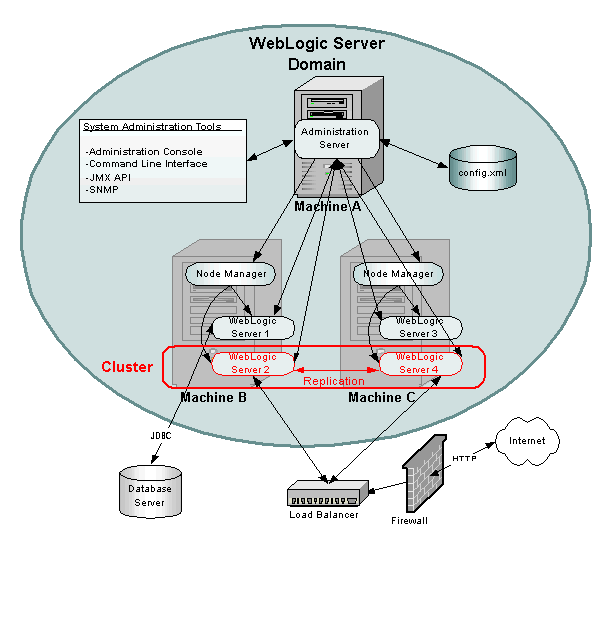Weblogic Admin Tutorials
Overview of WebLogic Server System
Administration
- Introduction to System Administration
- WebLogic Server Domains
- System Administration Infrastructure
- The Administration Server and Managed Servers
- System Administration Tools
- Resources You Can Manage in a WebLogic Server Domain
- Starting the Administration Console
- Using WebLogic Server with Web Servers
- Monitoring
- Licenses
Introduction to System Administration
You manage a WebLogic Server installation by using any of several system administration tools provided with WebLogic Server. A WebLogic Server installation can consist of a single WebLogic Server instance or multiple instances, each hosted on one or more physical machines. The system administration tools include the Administration Console, command line utilities, and an API, with which you manage security, database connections, messaging, transaction processing, and the runtime configuration of your applications. The tools also allow you to monitor the health of the WebLogic Server environment to ensure maximum availability and performance for your applications.
WebLogic Server Domains
The basic administrative unit for a WebLogic Server installation is called a domain. A domain is a logically related group of WebLogic Server resources that you manage as a unit. A domain always includes only one instance of WebLogic Server called the Administration Server. The Administration Server serves as a central point of contact for server instances and system administration tools. A domain may also include additional WebLogic Server instances called Managed Servers.
You can configure some or all of these Managed Servers to be part of a WebLogic Server cluster. A cluster is a group of WebLogic Server instances that work together to provide scalability and high-availability for applications. A Managed Server in a cluster can act as a backup for services such as JMS and JTA that are hosted on another server instance in the cluster. Your applications are also deployed and managed as part of a domain.
- Logical divisions of applications. For example, a domain devoted to end-user functions such as shopping carts and another domain devoted to back-end accounting applications.
- Physical location. Domains for different locations or branches of your business.
- Size. Domains organized in small units that can be managed more efficiently, perhaps by different personnel.
- Overview of WebLogic Server Domains
- Creating and Configuring Domains Using the Configuration Wizard
- Configuring Domains in the Administration Console Online Help
Figure 1-1 depicts a possible configuration of a WebLogic Server Domain—one of many possible configurations.
Machine A hosts one instance of WebLogic Server, the Administration Server. The System Administration Tools communicate with the Administration Server to perform configuration and monitoring of the servers and applications in the domain. The Administration Server communicates with each Managed Server on behalf of the System Administration Tools. The configuration for all the servers in the domain is stored in the configuration repository, the
config.xml file, which resides on the machine hosting the Administration Server.
Machines B and C each host two instances of WebLogic Server, WebLogic Servers 1 through 4. These instances are called Managed Servers. The Administration Server communicates with an instance of Node Manager running on each machine to control startup and shutdown of the Managed Servers.
WebLogic Servers 2 and 4 are part of a WebLogic Cluster (outlined in red). This cluster is running an application that responds to HTTP requests routed to the cluster from a hardware load balancer. (An instance of WebLogic Server or a third-party Web server with one of the WebLogic Server plug-ins can also provide load balancing.) The load balancer processes HTTP requests from the Internet after they have passed through a firewall. The load balancer and firewall are not part of the domain. A replicated copy of objects such as HTTP sessions is passed between the two cluster members to provide failover capability.
WebLogic Server 1 runs an application that uses Java Database Connectivity (JDBC) to access a database server running on another physical machine that is not part of the WebLogic Domain.
Note: The pictured domain is only intended to illustrate the concepts of a WebLogic Server domain and how you manage the domain. Many possible configurations of servers, clusters, and applications are possible in a WebLogic Server domain.

No comments:
Post a Comment